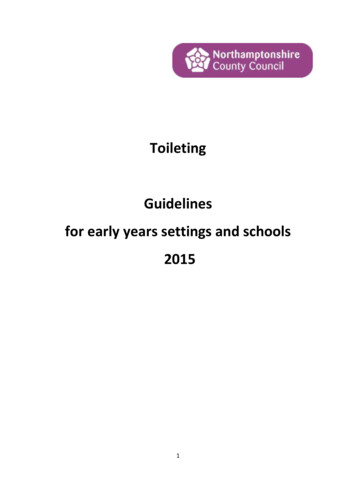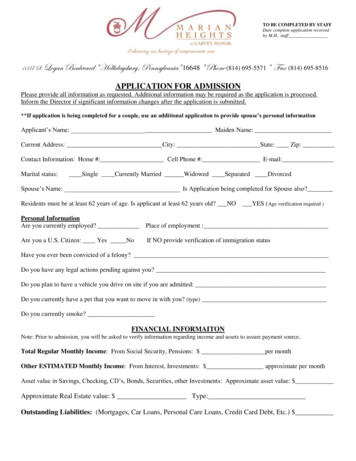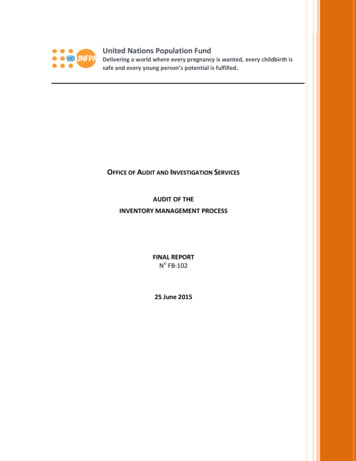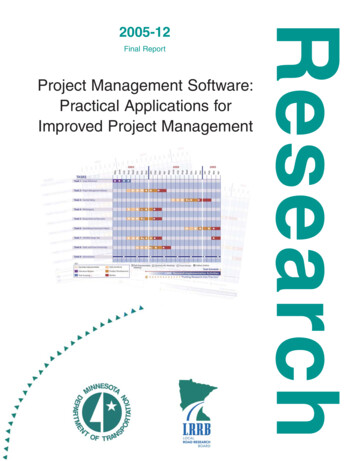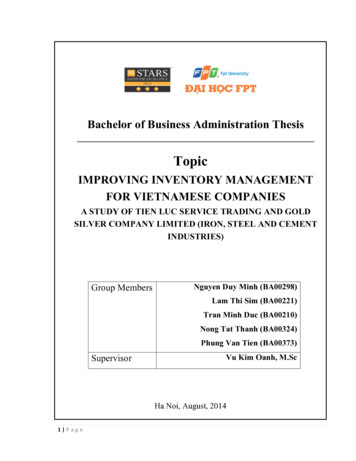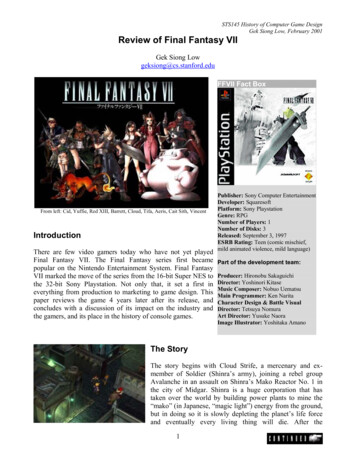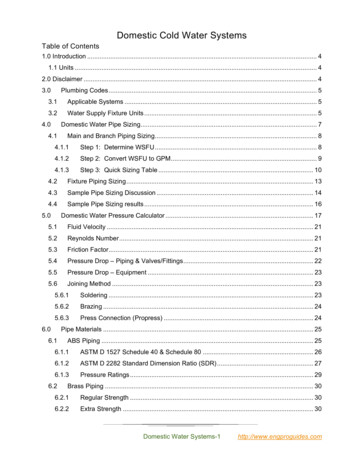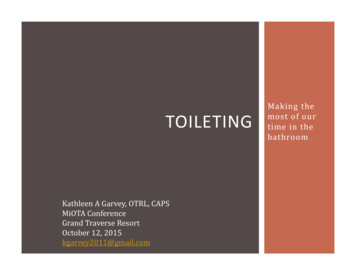
Transcription
TOILETINGKathleen A Garvey, OTRL, CAPSMiOTA ConferenceGrand Traverse ResortOctober 12, 2015kgarvey2011@gmail.comMaking themost of ourtime in thebathroom
OBJECTIVES OF PRESENTATION Define occupation of toileting as BADL Older adults Skilled nursing, community environments Discuss factors influencing performance using the PEO modellens: Person, Environment, Occupation Introduce toileting aids, The Freedom Wand highlighted Provide overview activity analysis Highlight results found in research literature review forevidenced based interventions to address toileting issues
OCCUPATIONAL THERAPY OWNS TOILETING Every day life activityEnhancing and enabling participation in habits, routinesPerformed in every locationIdentified as Basic Activity of Daily LivingDefined in AOTA practice frameworkHighly personal, functional, necessary, and meaningful
CLIENT FACTORS “ ‘Oh thank God I can go myself to the bathroom . You wouldthink it’s nothing. You’re young. You’ll understand when you’reolder, but the best thing in your life is when you can goyourself to the bathroom”. (p.130)-Rhoda Makover
“Most of ‘My Way’ of doing things in known only tome .Because most of these activities are done in isolation. Doyou know how many squares of toilet paper your spouse orloved one uses? Do they fold it before they use it; do theystand up before wiping? Although this may seem irrelevant,each individual routine becomes subconscious and tends tooccur exactly the same way every day and every time.”-LannyButler, MS, OTR
PREFERENCE IN TOILETING HABITS “Incorporating lifelong practices and preferences into careroutines provides a sense of familiarity to the older person,which can be comforting.” (Cohen-Mansfield and Jensen, 2005) Survey of 58 community dwelling seniors using SHAPEquestionnaire 1 out of 3 women surveyed used briefs, men did not report Most frequent problem is bladder continence No literature available giving description of daily behavior patternand preferences.
PREFERENCES Frequency of use is 4-6 times for day for both women andmen, with some as much as 31% higher. Less frequent use wasnot mentioned. Toilet tissue most commonly used bathroom product. Use of self care advanced directives from patient rather thanfamily members reccommended.
SELF CARE ADVANCED DIRECTIVE
BODY FUNCTIONS Visual FunctionsHearing functionsVestibular FunctionsPainJoint mobility and stabilityMuscle power, tone, enduranceMovement functionsCardiovascular/respiratory functionsGenitourinary functionsDigestive/metabolic functionsSkin functions
TOILETING DISABILITY Factors associated with Toileting Disability in Older AdultsWithout Dementia Living in Residential Care Facilities(Talley,Wyman, Bronas, Olson-Kellogg, McCarthy, Zhao, 2014) Toileting Disability “having difficulty with or requiring humanor mechanical assistance with toileting.”“Does the resident currently receive any assistance usingthe bathroom?” Answer: Yes
FACTORS AFFECTING TOILETING DISABILITY Factors:Reporting fair or poor healthLiving in a facility with 4 or less residentsLiving in a for profit facilityHaving bowel or bladder incontinenceMore physical impairments Ability to walk, stand, sit, stoop, reach, grasp, transfer positions, bath,disrobe and maintain continence Visual /hearing impairments Needing assistance with bathing, dressing and transferring
ACQUIRED TOILETING DISABILITYScreening question: Do you have any trouble controlling yourbladder; do you lose urine when you do not want to? 17% developed new UI at discharge, with odds of developingnew UI found to be 4.26 higher for UC users and 2.62 higherfor diapers.
ACQUIRED TOILETING DISABILITY Environmental barriers Incontinence status established from participant and surrogate reports,rather than from medical records, usually based on care provided. 44% of cases had indication for catheter: output for retention New UI diagnosis characteristics include: Older agePoorer cognitionHigher illness severity2 days longer stay
URINARY HEALTH Age doesn’t cause urinary incontinence, age-related changes maypredispose an individual Aging bladder associated with a reduced bladder capacity,increase in uninhibited contractions ,decreased urinary flow rate,diminished urethral pressure profile,increased post void residual urine volume. Key underlying mechanisms of voiding dysfunction deterioration of detrusor muscle function, bladder wall fibrosis increased sensitivity to neurotransmitters. Nocturia swelling in lower extremities and nighttime urineproduction
URINARY HEALTH Incontinence-affects up to 69% of the female population atsome point in their lives. “the complaint of any involuntary urinary leakage”International Continence Society Stress Urinary Incontinence (SUI) –involuntary leaking ofurine during effort or exertion, or while sneezing or coughing. Urgency Urinary Incontinence (UUI)-involuntary leakage ofurine accompanied by or immediately preceded by a suddencompelling desire to pass urine, which is difficult to defer. Mixed Urinary Incontinence (MUI)
QUALITY OF OUTPUT Urine Color Water is good Lemonade is okay Apple juice needs more hydration Coca cola need medical attention for dehydration
QUALITY OF OUTPUT
SUMMATION OF PERSON Preferences of older adults in self care Importance of habit and routine for comfort and optimalparticipation Physiological changes associated with age and/or illness Urinary health and higher incidence of incontinence secondaryto changes with age.
ENVIRONMENT Design for all approach (Demirkan and Olgunturk, 2014) Practical application of universal design Demands for all users should be valued on equal terms and the onesthat should be excluded should be made consciously. All users definedto include people with disabilities, elderly and average users. Research to determine if there is a significant difference amongadults, elderly and adults with disabilities and visual impairments interms of approach to produce a priority based list. Survey method, 161 individuals in Turkey,21-61, male/female, 60adults, 35 elderly
ENVIRONMENTTop nine items as they relate to bathroom/toileting: #1Adequate illumination level in all spaces (bathroom) #3 Adequate space for approach and use: All controls (light switches,window/door operators, electric outlets, etc) to require little effort #4 To have color contrast between the counter top and lavatory in thebathroom. #5 Ease of use in accessories:Faucets to be used easily in bathroom. #7 Provision of privacy and safety in the bathroomTo ilet to be used without helpTub shower to be used without helpTo ilets need to be used with low effort and minimum fatig ue #8 Safety of floors in all spaces: Floor to be slip resistant in the bathroom.“Perhaps it is more useful to think of everyone as possessing varyingdegrees of ability and disability instead of either fully-abled or disabled”(Duncan, 2007)
ENVIRONMENT Location of restroom Presence of a bathroom inside resident’s room/apartment notassociated with toileting disability, but survey did not ask aboutspaciousness of bathroom, presence of grab bars, and height of thetoilet seat (Talley, 2014) Toilet Wash and dry toilets in nursing homes(Mansfield and Biddison, 2005)Results:Technology beneficial for about half of residents in studyNo significant adverse affects encountered.Product improvements needed.
INAXLUSCENCELUXURYLAVAGEAdd on seat ine l o n ga te d o rro u n d w i t hre m o t e wa l lunit.
ENVIRONMENT Grab bars Smart Grab Bars (Guitard, Sveistrup, Fahim, Leonard, 2013)in bathtransfer Using visual, auditory and audio-visual cueing, smart grab bar useincreased by 39% after removal of cues. With grab bar use, decreased use of other structures. Those withhip/knee/leg and visual issues had higher bar use. Participants self-reported cues not helpful, but shown to have effecton behavior. Visual preferred, but auditory most useful Most participants had no grab bars in home. Grab bars must be grasped prior to transfer being attempted. Stigma associated with grab bars seemed to outweigh perceivedusefulness. Promote use of grab bars in all homes like seat belts in cars.
GRAB BARSREDEFINEDI nv i s i a d e s i g nfo r s t y l i s h g ra bbars toi n c or p ora t ei n t o b a t h ro omd e s i gn .
ENVIRONMENT Soap and towel Type Location Lower Body Clothing: Briefs, pants, s hoes Underwear, pad, brief-tab or pull up Waist and closure design Rubber bottom, closure, washable Roommate Voiding frequency Hygiene habits Sense of privacy Staff Demeanor and easeFamiliarityLevel of trustGender
ENVIRONMENT Objects needed for pericare Toilet PaperWet wipes: disposable and degradablePortable bidetPericare aid Freedom WandBottom buddyGroovyHome made
PERICARE Freedom WandWhat would you rather ask someone tohelp you with put on socks or wipe adirty bottom?Deborah Tacoma
PERICAREAIDSB o t t om B u d dyJobar LongRe a c h C o m fo rtWipe
SQUATTYPOTTYVo i d i n gp o s i t i onenhanced withra i s e d fe e t t omimicsquatting.
DURABLE MEDICAL EQUIPMENT Mechanical lift Slings Wheelchair or walker Brakes, length, strength, cueing Armrests, height, hinge or pin for moving Raised toilet seat Drop armBariatricHeight, funnel, opening sizeOver the toilet or lock in with handles Bed side commode Urinal Bedpan
SUMMATION OF ENVIRONMENT Evidence for importance of environmental supports for allusers Technological enhancements improve comfort and safety Features of DME and task objects should be considered topersonalize and enable participation to establish safe routine.
ACTIVITY ANALYSIS: STEPS TO TOILET 1.Have urgency to empty bowel or bladder2.Perform functional mobility to enter restroom.3.Open door to restroom4.Close door to restroom5.Position body in front of toilet.6.Doff LB clothing to access anus, vagina and/or penis.7.Sit down or stand in proper proximity for elimination.8.Urinate and/or defecate9.Clean off urine or fecal matter from skin surface.10.Don LB clothing11.Perform functional mobility to sink.12. Wash and dry hands at sink.13. Exit bathroom.
OCCUPATION Avoid denying urge to urinate. Every 3-6 hours. Hydration toavoid irritants of concentrated urine. Sequencing of task UTI preventionPositioning for voidingTake time to relax and allow muscles to work.Time duration neededActivity energy demandsPrivacy, sensory, psychological componentsPersonal standards of hygieneDaily routine at home versus in rehab facilityNatural versus prescribed schedule
OCCUPATION ORGANIZATION Task simplification Education of client and caregiver Accommodation and compensatory strategies to enhanceparticipation.
INTERVENTIONS Lifestyle interventions Fluid intake during the day: ideally 8 glasses of 8 oz throughout dayReduction of caffeineBMI or 30 weight reduction can reduce incontinenceHigh fiber food to avoid constipationIncreased physical activity can improve walking, balance, transfers onand off the toilet. Behavioral therapies Pelvic floor muscle exercises according to specific protocolTimed voiding (cognitive impairments)with support of caregiverHabit retraining using bladder diary to develop toileting schedulePrompted voiding with cueing initiation and assistance. Contraindications: 2 person assist, 1/3 successful voiding, no greater than20% decrease in incontinent episodes
INTERVENTION “Occupational and physical therapy could be used to improvedressing, bathing, and transferring skills” (Talley, 2014). Physical activity programs targeting impairments withwalking, standing, sitting, stooping, reaching and grasping,and therapy to improve dressing and transferring skills.
INTERVENTIONS Systematic review of intervention studies of incontinencemanagement in care homes, 1966-2010 (Flanagan, et al, 2012) RCT Prompted voidingDoes not change from dependent to independentMedication contributed to reduction, but not clinically meaningfulExercise might contribute to wetness reduction and toiletingimprovement.
INTERVENTIONS “Incondition program” Strength of pelvic floor muscles Bladder control: knowledge about continence, position/relaxation toiletbehavior, Mobility Accessible, fun and easy to understand Low intensity Weekly 1 hour training for 6-10, 22 weeks Care as usual Incontinence pads Toilet assistance “Over the course of our study, it became apparent that, in mosthomes, the emphasis is on controlling incontinence at aninstitutional level rather than on solving or preventing it at anindividual level” (Tak et al, 2012)
INTERVENTIONS Determine the feasibility and effect of training and mobilityskills on dependent, non demented, elderly women with longstanding urinary incontinence (Van Houten, Acterberg, andRibbe, 2007) 8 week training course of mobility and training courseprovided by PT/OT. Results: 37.7% reduction in urine lost 3 women became continent in control group 6/2 women dependent to independent toileting in intervention/control groups Not statistically significant, however significant effect on daytimesum score of toilet timing test. High motivation was a key factor in use of toileting skills.
INTERVENTION POTTI test: Time a participant needs to perform thesubsequent tasks associated with going to the toilet understandardized circumstances. Time Need to Perform Task Walking Participants: 1. Get up from a bed /get up from a chair2. Walk 5m3.Undo a hook, button or zipper4. Let down garments and sit down on the toilet5. Rise from the toilet and adjust garments
INTERVENTIONS Participants in a wheelchair1. Get up from a bed.2. Ride 5 m in the wheelchair3. Undo a hook, zipper, and button.4. Transfer from the wheelchair to the toilet (including letting downgarments and taking seat on the toilet.) 5. Transfer from the toi
Title: Microsoft PowerPoint - toileting_garvey_final Author: Claudette Created Date: 10/11/2015 11:25:56 AM
